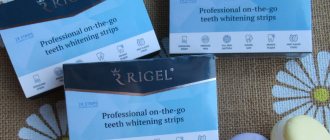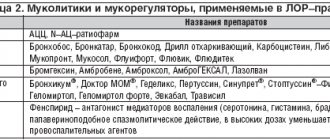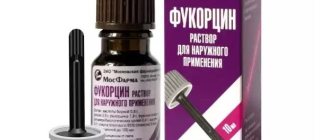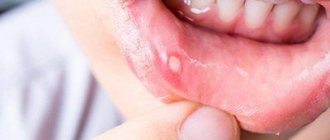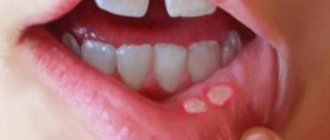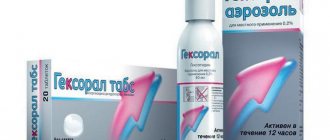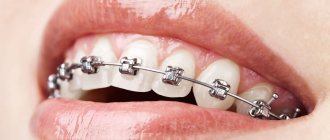Stomatitis is an inflammation of the oral mucosa with the formation of characteristic ulcers and plaque. The disease most often affects older people and children. The main reason is a decrease in the protective function of the immune system. The mucous membrane is dotted with pustules and ulcers.
Children begin to worry about this pathology after suffering from inflammatory diseases. Fungal (candidal) stomatitis can develop during breastfeeding if hygiene standards are violated.
It has been noticed that in children under seven years of age, stomatitis manifests itself more aggressively - the ulcers are denser and larger than in adults. This is due to the fact that the oral mucosa, as well as the child’s immune system, are at the stage of formation. Babies produce more saliva. In such conditions, pathogens multiply much better.
The choice of treatment methods depends on the cause and type of disease. For stomatitis of various forms, doctors prescribe Fukortsin solution in one form or another.
What is Fukortsin used for?
The pronounced antimicrobial effect allows Fukortsin to be used as a local antiseptic that fights potential infection of wounds and abrasions. In addition, the drug has a fungicidal effect, which means it can prevent the proliferation of fungus. The main purposes of Fukortsin are:
- purulent wounds;
- superficial damage to the skin;
- erosion;
- abrasion;
- deep cracks;
- fungal infection of the epidermis.
Diagnosed streptoderma is treated with the timely use of Fukortsin.
Fukortsin for herpes on the face
The drug does not have the ability to affect the herpes virus. However, when applied to the ulcers that it causes, Fukortsin dries them out, prevents them from growing and significantly reduces the area affected by the virus. Therefore, the drug is used as an additional remedy in the treatment of herpes.
A cotton swab is moistened in the solution and Fukortsin is applied to the herpes blisters. It is recommended not to simply spread the solution on the skin, but to hold the moistened cotton swab on the affected area for 1-2 minutes.
A drug that can fight stomatitis!
Fukortsin solution is often prescribed for the treatment of stomatitis in adults and children over one year of age. The product has a pronounced complex effect, dries well, eliminates fungal and bacterial infections, and reduces the likelihood of re-infection.
The solution is prescribed for the treatment of stomatitis, as well as herpes. In the latter case, characteristic crimson spots appear on exposed areas of the skin; in such situations, the product is often used in pediatrics.
The peculiarity of the medicine is that the solution is effective in treating all types of stomatitis. For candidiasis (children most often suffer from it), it is important to use a raspberry-colored solution. It is more effective in fighting fungal infections.
The product is very effective, acts quickly, and is inexpensive. But you should use it with caution to treat stomatitis in children under one year of age; Fukortsin can cause allergies in them.
The main active ingredients of the drug are boric acid and acetone (they have a pronounced antimicrobial effect). The drug contains phenol (effective against fungal infections).
Fukortsin is prescribed for:
- stomatitis with purulent discharge;
- microtraumas of the oral cavity;
- fungal infections;
- focal erosions on the skin.
For the listed pathologies, Fukortsin is used in combination with other drugs.
For stomatitis, the drug is prescribed for local use. Dentists prescribe the remedy for the development of pustules. The solution is carefully applied pointwise to ulcers and ulcers.
How to take Fukortsin for stomatitis
Stomatitis is an inflammation of the mucous membranes of the oral cavity, which is accompanied by the appearance of ulcers and abscesses. The disease usually occurs most often in children between one and three years of age. And this is due to the fact that during the period of teething, the child takes accessible objects into his mouth, some of which are unclean. Dirt entering the inflamed gum causes infection, which leads to the spread of ulcers throughout the oral cavity.
Adults, paying little attention to dental health, provoke the spread of infection. Stomatitis makes it impossible to eat normally, since any substances that get on the ulcer cause severe pain. Stomatitis is treated by rinsing with decoctions of chamomile or oak bark. And you need to treat wounds with Fukortsin, after moistening a cotton swab or swab in the solution.
Under no circumstances should Fukontsin be used as a mouth rinse. Tissues and mucous membranes have a high degree of absorption. During rinsing, a large percentage of boric acid and phenol will be absorbed into the blood, which will certainly cause general intoxication of the body
Instructions for use
The solution must be used spot on. The following algorithm should be followed:
- Plaque in the oral cavity must first be removed. This will ensure maximum access of active substances to the affected tissues. You need to soak a cotton swab in tea tree or sea buckthorn oil. Then the plaque is carefully removed from the ulcers.
- Apply the solution to the affected area with a cotton swab. Do not touch healthy areas.
- After 40 minutes, other anti-stomatitis agents (creams, gels, sprays) are applied.
- After an hour, you can apply Candide or Kamistad ointment to the treated areas.
- If the doctor has not prescribed any additional medications, then after 2 hours you need to rinse your mouth well. Otherwise, the mucous membrane will be dry.
- Do not use the product more than 4 times a day. If overused, a burning sensation and pain may occur. If used improperly, Fukortsin can cause burns.
An allergy test is required!
A slight burning sensation may occur during application, but do not be alarmed by it. In a minute it will pass. Fukortsin is used to treat stomatitis in children over 12 years of age (in rare cases and as prescribed by a doctor from one year old) and adults. It is applied 3-4 times a day. The course of treatment is no more than ten days, for a child – no more than five.
The drug is recommended for use after 12 years. You must first do a sensitivity test. It is important not to use the medicine often and for a long time, since the delicate children's mucous membrane can be easily injured. For children, the duration of treatment is 5 days.
Note! Fukortsin is not used to treat stomatitis in young children! It is contraindicated for infants. This is due to the fact that its components are quite toxic.
You need to be especially careful when combining this remedy with other drugs. Unexpected reactions of active components are possible! Therefore, it is not recommended to use other medications simultaneously with Fukortsin without a doctor’s permission.
Fukortsin or brilliant green for chickenpox
With chickenpox, treating blisters on the body has a special meaning. Chickenpox is a type of herpes virus that causes a rash all over the body. Doctors do not recommend getting the affected areas of the body wet, which means the patient should not wash during the entire period of illness, which can last up to 14 days. The patient is considered infectious as long as new lesions of the rash appear on his body. As soon as the rash stops appearing, make a mark on the calendar and count another 5 days, after which the patient with chickenpox can return to the team.
Zelenka, like Fukortsin, in addition to drying out sores, preventing a secondary infection from joining, serves as a kind of marker for a previously appeared rash. The absence of uncolored bubbles will indicate that the disease is receding.
The child, reacting to the itching that often accompanies the chickenpox rash, tries to scratch it, breaking the tightness of the ulcers. Dirt and infection can quickly get into a torn wound, which will cause suppuration and other complications. Fukortsin, like brilliant green, does an excellent job of disinfecting. What color the patient will be after treatment is a decisive factor influencing the choice between the two drugs. Both brilliant green and Fukortsin are difficult to wash off from the skin.
From real life
From the reviews, some conclusions can be drawn about the effectiveness or ineffectiveness of Fukortsin in the context of the treatment of stomatitis.
At the age of 6, my daughter fell ill with stomatitis. Ulcers and pustules appeared. The baby was in pain. The doctor prescribed Fukortsin.
Gently lubricated the wounds with the solution for five days. Already on the second day it was noticeable that the ulcers began to dry out. A good drug, fast acting, inexpensive.
Elena, 21
After suffering from ARVI, my oral mucosa became inflamed. Mom advised me to cauterize the pustules with Fukortsin, which I did. The drug helped very quickly. True, at first there was a slight tingling sensation, but everything was tolerable. I would not use it on the skin, as the medicine has a bright pink tint. But for the mucous membrane - just what you need!
Lilia, 34
Adverse reactions
Sometimes, if the solution is abused, inflammation of the treated areas of the skin may occur, accompanied by burning or itching. A similar effect is achieved by prolonged contact of the epidermis with the active substance. Treatment of adverse reactions is symptomatic:
- Wash off excess solution from skin using soap and running water.
- Apply a cream containing dexpanthenol to the skin, excluding the wound itself.
- Stop using Fukortsin.
Stomatitis - symptoms and treatment
The main goal of treating stomatitis is to prevent the lesion from spreading throughout the entire oral mucosa and to prevent the disease from becoming chronic. First of all, it is necessary to determine the form and stage of the disease, since treatment tactics will depend on this. Treatment is complex: both local and general.
For all types of stomatitis, professional oral hygiene . It is the removal of dental deposits such as tartar and soft pigmented plaque.
Effective drugs for the treatment of stomatitis in adults
Next, it is necessary to eliminate chronic foci of infection and predisposing factors. For painful ulcers, anesthesia of the oral mucosa :
- applications of a 2% solution of procaine (Novocaine);
- applications of 2% lidocaine solution [7].
The affected mucous membrane is treated with antiseptics (0.02% Furacilin solution; 0.06% chlorhexidine solution; 0.1% Dimexide solution).
Applications of collagen films with various medicinal substances, for example, corticosteroid drugs, Diphenhydramine, and anesthetics, are also used. This film attaches to the erosion and has anti-inflammatory and antiallergic effects, after which it dissolves on its own. To accelerate the healing of the mucosal epithelium, an oil solution of vitamin A, rosehip oil, and dental adhesive paste with solcoseryl are used.
How can you rinse your mouth for stomatitis?
When treating stomatitis, it is very important to identify the cause and eliminate it. Rinsing the mouth with antiseptic solutions (0.02% Furacilin solution, 0.06% Chlorhexidine solution) or herbal decoctions will reduce swelling and inflammation, but this is not the main method of treatment.
General treatment
Includes adherence to a diet (it is not recommended to consume spicy, spicy, rough foods, alcoholic beverages), as well as the use of antihistamines, antivirals, antibacterial, antifungal drugs (depending on the form of stomatitis) and sometimes glucocorticosteroids (GCS) - analogues of natural hormones of the adrenal cortex [6 ].
Desensitizing therapy : orally “Tavegil”, “Diphenhydramine”, “Suprastin”, 1 tablet 2 times a day for a month.
Antifungal therapy is carried out for candidal stomatitis: tablets “Nystatin”, “Nizoral”, “Diflucan” [9].
For viral stomatitis, antiviral drugs are prescribed: Lavomax, Valtrex, Bonafton. In severe forms of stomatitis, corticosteroids can be prescribed: prednisolone 15-20 mg per day, the dose of the drug is reduced by 5 mg per week from the moment of epithelization of erosions and ulcers.
For stomatitis, restorative therapy . Vitamins of group B, C, PP. Imudon tablets have an antiseptic effect, normalize microflora, and increase local immunity [11].
From the first day of the patient’s treatment until complete epithelialization, physiotherapy : ultraviolet irradiation, helium-neon laser, laser biostimulation of blood.
Laser treatment of stomatitis
Laser in the treatment of stomatitis is especially effective if the oral mucosa is affected by bacteria, viruses or fungi. The laser beam is targeted specifically at the affected area of the mucous membrane without damaging healthy tissue. The method allows you to destroy microbial cells, reduce pain and swelling, improve microcirculation, which promotes healing. The procedure is painless and safe.
How to cure stomatitis in a child
The principles of treating stomatitis in children and adults are similar, but it is important for the doctor to take into account the age of the child and correctly calculate the dosage of drugs. Another feature is that young children will not be able to rinse their mouths or use mouth baths. Therefore, antiseptic treatment of the oral cavity is carried out by parents with a finger wrapped in several layers of gauze and soaked in an antiseptic solution.
Treatment of stomatitis at home
If symptoms of stomatitis appear, you should immediately consult a doctor. Self-diagnosis and treatment with folk remedies often aggravate the disease.
special instructions
It is highly not recommended to treat large surface areas of the skin with Fukortsin, as this will lead to intoxication with phenol, which is part of the drug, which will cause weakness, surges in blood pressure, respiratory distress and dizziness.
Before handling the bottle, it is recommended to wear rubber or polyethylene gloves to protect your hands from accidental contact of the dye with your skin. Like brilliant green, Fukortsin can stain objects that receive random drops while unsealing the bottle. Therefore, it is better to cover the table or cabinet on which the bottle will stand with a waterproof napkin.
Contraindications and special instructions for use
The drug is contraindicated during pregnancy, lactation and for children under 12 years of age (categorically up to one year, exceptions are possible after this age). Since the composition contains phenol, the product should not be applied to large areas.
The drug can provoke allergies, so you need to do a sensitivity test. Just apply a little product to the crook of your elbow and wait, if there is no itching, redness, or rash, the product can be used.
The medicine should be used with caution by those people who have hypersensitivity to its components. It is contraindicated for allergies and dermatosis.
You cannot use the drug for a long time, it can be addictive, which leads to a decrease in effectiveness.

